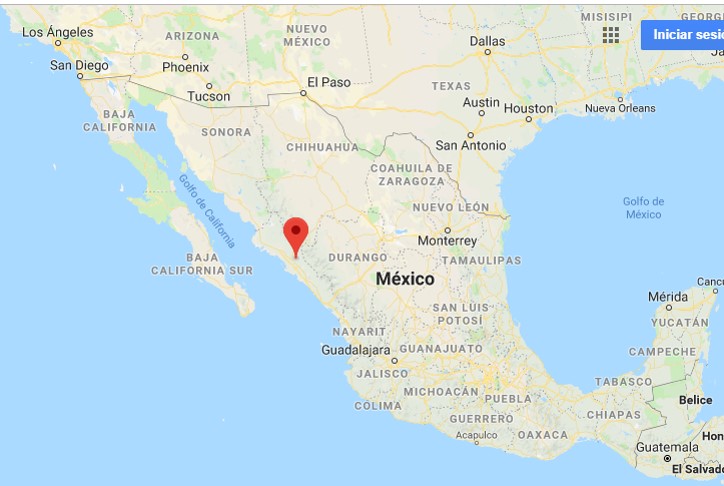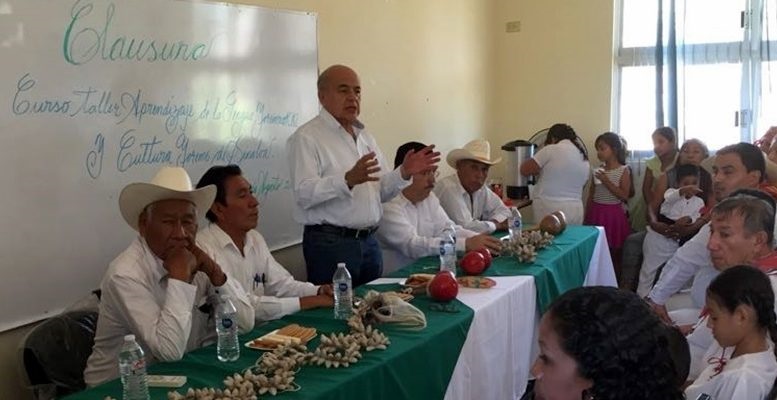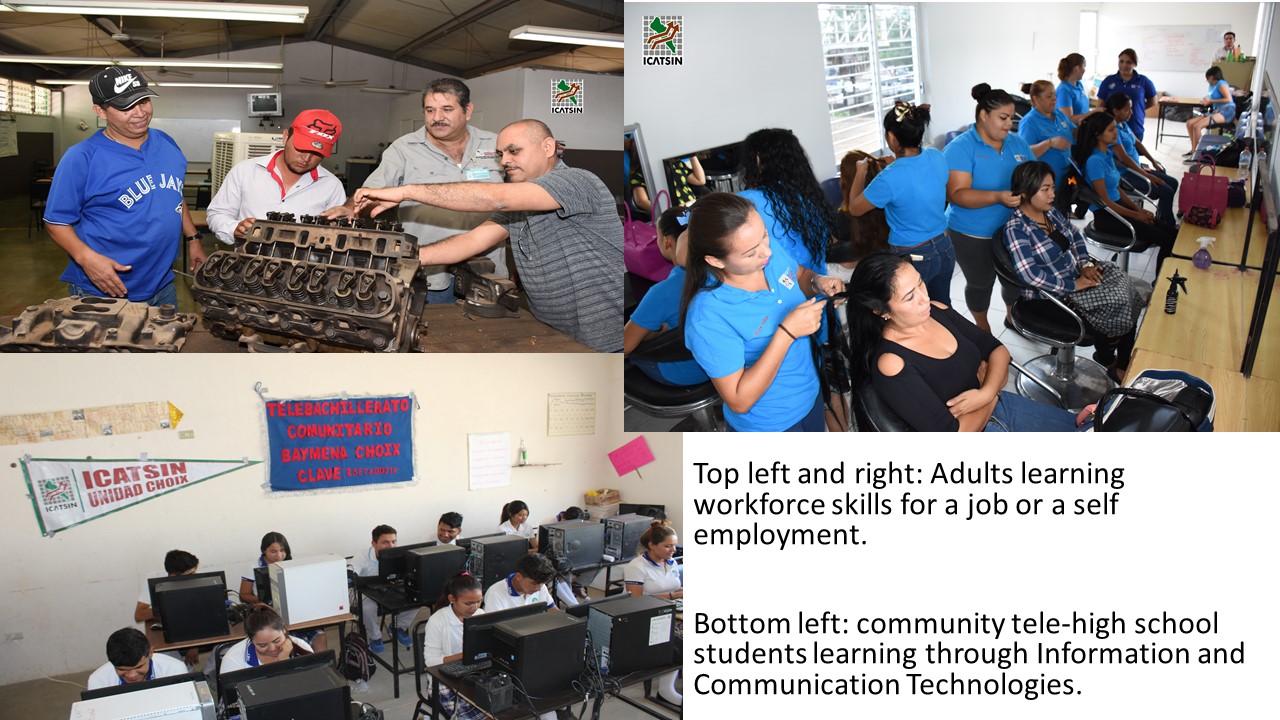Making the difference for sinaloense vulnerable groups: inclusive and equitable quality education and promoting lifelong learning opportunities for all: a cooperative transversal practice to develop relevant skills for a decent job and self-employment
Description
The mexican northwest Sinaloa State has 2,966,321 inhabitants and inequality gaps: 31% live in poverty, 40% suffer a vulnerable socioeconomic situation, in contrast to 29 % of sinaloenses neither poor nor vulnerable. Engaged with the 2030 Agenda for Sustainable Development, since 2017, the Sinaloa State Workforce Training Institute (Icatsin), has implemented a cooperative transversal practice with government and diverse organizations, to reach 5% annual increase of vulnerable people who can receive education for a decent job, self-employment or entrepreneurship. Currently, 29,547 are beneficiaries: female heads of family, inmates, older persons, indigenous peoples, and disabled persons into the poorest five municipalities.
The cooperative transversal practice goal is to reach 5% annual increase of attended people from vulnerable groups through an education aligned which contributes to meet with the individuals needs to get a licit, decent, well-paid employment or self-employment, as well as the demands of the productive and social sectors. On 2017, the Sinaloa State Workforce Training Institute (Icatsin) -composed of 19 centers and 7 Mobile Training Units- linked its mission to the 2030 Agenda for Sustainable Development by using the Michael Porter's Five Forces analysis model in the design of the Institutional Development Program 2017-2021 (IDP Icatsin). The IDP Icatsin includes the cooperative transversal practice to attend vulnerable groups by providing a workforce education aligned to meet individuals needs to get a licit, decent, well-paid employment and self-employment, as well as trends of the productive and social sectors. This institutional practice has the following elements: Vulnerable groups-targeted: female heads of family, older persons, indigenous peoples, inmates, disabled people or unemployed youth, throughout the Sinaloa state, mainly into the five municipalities classified as the poorest locations because 50% and more of their inhabitants live in poverty (Badiraguato, Cosala, Choix, Sinaloa, and Mocorito). A cooperative transversal strategy among Icatsin, government dependencies, town halls, private business organizations, and non-profit organizations to exchange diverse resources as a part of their agendas to empower vulnerable people with useful education for jobs and good income. It is enacted a coordination mechanism through legal agreements made by the Icatsin with the other parties. It includes formulating the co-responsibilities, to select proper places, to authorize a deadline to achieve through providing courses and specialties designed by petition or selected from a catalog- for developing knowledge and skills necessaries to prepare them to get a decent job, self-employment and entrepreneurship. Several checklist formats, academic supervision are used to evaluate each course. It is collected the information from government public or official reports of participating organizations; the Icatsin internal supervision reviews the reports and submit them to an external audit under mexican laws.<br />
Two indicators incorporated to measure the social impact of the Icatsin's strategic planning process. Firstly, to ensure that of the total Icatsin annual enrollment, the 5% it will be composed of vulnerable groups and the next year, it will be a new 5% increase. Secondly, the Employability indicator related to the persons graduated from Icatsin, who get a job or a better economic income as a result of the educational services received. <br />
About how Icatsin met the main challenges and overcame the difficulties, the solution was to detect and to report that the common risks. Vulnerable people who left the courses because they have to get another job to survive, or they deal with lack of money to continue the studies. In prevention, the Icatsin donate economic aid (scholarship), and the personnel of institution interviews the enrolled persons who want to leave to reincorporate them. Furthermore, there is a job exchange coordination to increase further opportunities, once the vulnerable people finish the courses.
The implementation methodology, used by the Icatsin to attend the vulnerable groups, is based on the government administration public policies. The 5% annual increase was formulated to educate the vulnerable people through workforce training courses, specialties for job and entrepreneurship assessment. Then it is established a plan of action supported by a legal agreement between the Icatsin and other Parties (governmental dependencies, town halls, non-profit organizations). The reports are generated every three months to monitor the enrolment, and accreditation of the courses and assessment proposed through legal agreements. The evidence includes a students' signature list of attending classes and instructions, teacher reports, photos of people in the performance of the expected skills, and so on. April and September, an official report is published by the Icatsin and delivered to the Board of Directors from the state government, universities, and government legal department. Statistics are analyzed to know to what extent the goal is achieving. Also, the common risks are detected and reported: vulnerable people who left the courses because they have to get another job to survive, or they deal with lack of money to continue the studies. In prevention, the Icatsin donate economic aid (scholarship), and the personnel of institution interviews the enrolled persons who want to leave to reincorporate them. Furthermore, there is a job exchange coordination to increase further opportunities, once the vulnerable people finish the Icatsin courses. As a part of the Icatsin Institutional Development Program 2017-2021, twice a year, the institutional self-assessment is implemented. The purpose is to obtain a detailed diagnosis of strengths and weakness of the execution of the program: academic capacity (teachers, courses), institutional linkage (legal and educational arrangements to organizations and communities). It is useful to evaluate how to go forward with the traced goal. Also, the plans of actions and legal agreements documents allow to identify the components of how to plan, to execute and to evaluate to be ready if another organization wanted to transfer the practice.
The cooperative transversal practice was made to make the difference for sinaloense vulnerable groups by ensuring inclusive and equitable quality education to develop the youth and adults' relevant skills for a decent job and self-employment. Through legal agreements, the Sinaloa State Workforce Training Institute (Icatsin) achieved a total of 80,000 training actions reached from January 2017 to December 2018 (4,400 training actions more than those expected to fulfill). Main results indicate that in 2017 the 28,159 vulnerable people were attended while in 2018, they were 37,535. In a broader view, on 2018, the Icatsin obtained excellent results in the five poorest municipalities: 1,315 training actions in Choix; 950 in Cosala; 169 in Mocorito (103 to inmates and 66 to disabled persons). Also, 1,160 in Sinaloa (72 to female heads of family, 71 to indigenous peoples, and the rest to people with lower income); 785 in Badiraguato (34 female heads of family and the rest to people with lower income). The lesson learned in this first year of implementation is that all effort is not ship nor expensive but worth when we are talking about persons who need an opportunity to improve through education for a job which leads them to obtain relevant skills to access and success in a decent job and self-employment.
SDGS & Targets
Deliverables & Timeline
Resources mobilized
Partnership Progress
| Name | Description |
|---|
Feedback
Action Network


Timeline
Entity
SDGs
Region
- Latin America and the Caribbean
Geographical coverage
Photos



Website/More information
Countries
Contact Information
Margarita Aleman Vargas, PhD
